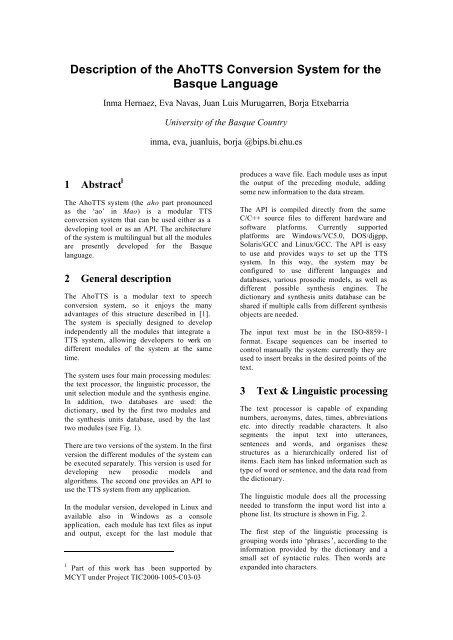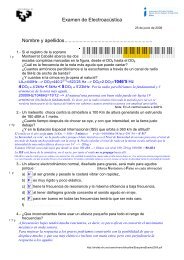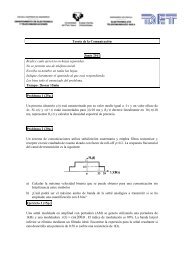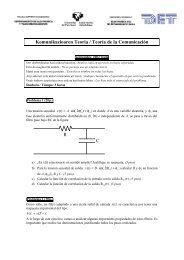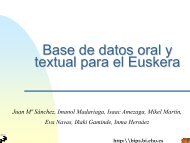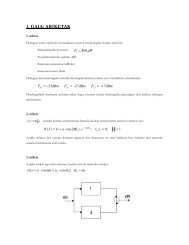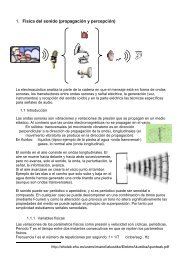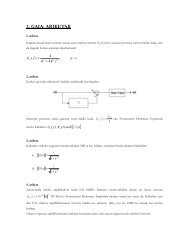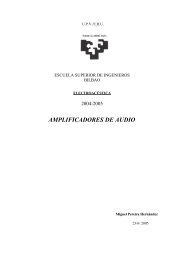Description of the AhoTTS Conversion System for the Basque ...
Description of the AhoTTS Conversion System for the Basque ...
Description of the AhoTTS Conversion System for the Basque ...
You also want an ePaper? Increase the reach of your titles
YUMPU automatically turns print PDFs into web optimized ePapers that Google loves.
<strong>Description</strong> <strong>of</strong> <strong>the</strong> <strong>AhoTTS</strong> <strong>Conversion</strong> <strong>System</strong> <strong>for</strong> <strong>the</strong><br />
<strong>Basque</strong> Language<br />
Inma Hernaez, Eva Navas, Juan Luis Murugarren, Borja Etxebarria<br />
University <strong>of</strong> <strong>the</strong> <strong>Basque</strong> Country<br />
inma, eva, juanluis, borja @bips.bi.ehu.es<br />
1 Abstract 1<br />
The <strong>AhoTTS</strong> system (<strong>the</strong> aho part pronounced<br />
as <strong>the</strong> ‘ao’ in Mao) is a modular TTS<br />
conversion system that can be used ei<strong>the</strong>r as a<br />
developing tool or as an API. The architecture<br />
<strong>of</strong> <strong>the</strong> system is multilingual but all <strong>the</strong> modules<br />
are presently developed <strong>for</strong> <strong>the</strong> <strong>Basque</strong><br />
language.<br />
2 General description<br />
The <strong>AhoTTS</strong> is a modular text to speech<br />
conversion system, so it enjoys <strong>the</strong> many<br />
advantages <strong>of</strong> this structure described in [1].<br />
The system is specially designed to develop<br />
independently all <strong>the</strong> modules that integrate a<br />
TTS system, allowing developers to work on<br />
different modules <strong>of</strong> <strong>the</strong> system at <strong>the</strong> same<br />
time.<br />
The system uses four main processing modules:<br />
<strong>the</strong> text processor, <strong>the</strong> linguistic processor, <strong>the</strong><br />
unit selection module and <strong>the</strong> syn<strong>the</strong>sis engine.<br />
In addition, two databases are used: <strong>the</strong><br />
dictionary, used by <strong>the</strong> first two modules and<br />
<strong>the</strong> syn<strong>the</strong>sis units database, used by <strong>the</strong> last<br />
two modules (see Fig. 1).<br />
There are two versions <strong>of</strong> <strong>the</strong> system. In <strong>the</strong> first<br />
version <strong>the</strong> different modules <strong>of</strong> <strong>the</strong> system can<br />
be executed separately. This version is used <strong>for</strong><br />
developing new prosodic models and<br />
algorithms. The second one provides an API to<br />
use <strong>the</strong> TTS system from any application.<br />
In <strong>the</strong> modular version, developed in Linux and<br />
available also in Windows as a console<br />
application, each module has text files as input<br />
and output, except <strong>for</strong> <strong>the</strong> last module that<br />
1 Part <strong>of</strong> this work has been supported by<br />
MCYT under Project TIC2000-1005-C03-03<br />
produces a wave file. Each module uses as input<br />
<strong>the</strong> output <strong>of</strong> <strong>the</strong> preceding module, adding<br />
some new in<strong>for</strong>mation to <strong>the</strong> data stream.<br />
The API is compiled directly from <strong>the</strong> same<br />
C/C++ source files to different hardware and<br />
s<strong>of</strong>tware plat<strong>for</strong>ms. Currently supported<br />
plat<strong>for</strong>ms are Windows/VC5.0, DOS/djgpp,<br />
Solaris/GCC and Linux/GCC. The API is easy<br />
to use and provides ways to set up <strong>the</strong> TTS<br />
system. In this way, <strong>the</strong> system may be<br />
configured to use different languages and<br />
databases, various prosodic models, as well as<br />
different possible syn<strong>the</strong>sis engines. The<br />
dictionary and syn<strong>the</strong>sis units database can be<br />
shared if multiple calls from different syn<strong>the</strong>sis<br />
objects are needed.<br />
The input text must be in <strong>the</strong> ISO-8859-1<br />
<strong>for</strong>mat. Escape sequences can be inserted to<br />
control manually <strong>the</strong> system: currently <strong>the</strong>y are<br />
used to insert breaks in <strong>the</strong> desired points <strong>of</strong> <strong>the</strong><br />
text.<br />
3 Text & Linguistic processing<br />
The text processor is capable <strong>of</strong> expanding<br />
numbers, acronyms, dates, times, abbreviations<br />
etc. into directly readable characters. It also<br />
segments <strong>the</strong> input text into utterances,<br />
sentences and words, and organises <strong>the</strong>se<br />
structures as a hierarchically ordered list <strong>of</strong><br />
items. Each item has linked in<strong>for</strong>mation such as<br />
type <strong>of</strong> word or sentence, and <strong>the</strong> data read from<br />
<strong>the</strong> dictionary.<br />
The linguistic module does all <strong>the</strong> processing<br />
needed to trans<strong>for</strong>m <strong>the</strong> input word list into a<br />
phone list. Its structure is shown in Fig. 2.<br />
The first step <strong>of</strong> <strong>the</strong> linguistic processing is<br />
grouping words into ‘phrases ’, according to <strong>the</strong><br />
in<strong>for</strong>mation provided by <strong>the</strong> dictionary and a<br />
small set <strong>of</strong> syntactic rules. Then words are<br />
expanded into characters.
Text<br />
processing<br />
Linguistic<br />
processing<br />
Unit selection<br />
Syn<strong>the</strong>sis<br />
engine<br />
Dictionary<br />
Syn<strong>the</strong>sis<br />
units<br />
<strong>AhoTTS</strong><br />
Fig. 1: Modules <strong>of</strong> <strong>AhoTTS</strong> system.<br />
Non orthographic breaks are also inserted if<br />
needed, and <strong>the</strong>n <strong>the</strong> phonetic transcription is<br />
done by rule using SAMPA phones. Next, after<br />
segmentation into syllables, <strong>the</strong> accents are<br />
placed by rule [2].<br />
Prosodic in<strong>for</strong>mation is <strong>the</strong>n added to each<br />
phone. First <strong>of</strong> all, segmental duration is<br />
calculated. <strong>AhoTTS</strong> has two different models<br />
<strong>for</strong> per<strong>for</strong>ming this task: a statistical model that<br />
uses CART [3] techniques to decide phoneme<br />
duration and a model that sets duration by rule,<br />
based on [4].<br />
Once duration is set, F0 values are calculated<br />
<strong>for</strong> each phone. A variable number <strong>of</strong> F0 values<br />
can be supplied <strong>for</strong> each phone by <strong>the</strong> F0 model.<br />
Currently two F0 models are available. A<br />
simple model [5] assigns peaks to <strong>the</strong> accented<br />
syllables and draws valleys to <strong>the</strong> unstressed<br />
syllables. The second model, more elaborated,<br />
follows Fujisaki’s method [6] and <strong>the</strong><br />
parameters <strong>of</strong> <strong>the</strong> model are derived using<br />
CARTs [7].<br />
Linguistic processing ends assigning by rule a<br />
power level to each phone.<br />
Both <strong>the</strong> text processor and <strong>the</strong> linguistic<br />
module use <strong>the</strong> dictionary to per<strong>for</strong>m <strong>the</strong>ir tasks.<br />
The dictionary contains mainly acronyms and<br />
words with in<strong>for</strong>mation <strong>of</strong> different nature about<br />
<strong>the</strong>m, but as <strong>Basque</strong> is a suffixed language and<br />
words are constructed by accumulation <strong>of</strong><br />
suffixes, character groups smaller than words<br />
not necessarily equal to morphemes or suffixes<br />
are also stored.<br />
Each entry has as much linked coded<br />
in<strong>for</strong>mation as necessary. For example, an<br />
acronym usually needs only <strong>the</strong> expanded<br />
expression, but a word might contain syntactic<br />
in<strong>for</strong>mation, <strong>the</strong> position <strong>of</strong> <strong>the</strong> accent,<br />
indication about breaks... Up to 14 different<br />
groups <strong>of</strong> properties can be associated to every<br />
dictionary entry.<br />
syntactic info<br />
words to characters<br />
break insertion<br />
grapheme to phoneme<br />
syllable boundary<br />
stress<br />
segmental duration<br />
pitch<br />
power<br />
Fig. 2: Structure <strong>of</strong> <strong>the</strong> linguistic processor in<br />
<strong>AhoTTS</strong>.<br />
The dictionary is created initially as an ASCII<br />
file. Afterwards it might be compiled to a binary<br />
file to speed up <strong>the</strong> search during <strong>the</strong> syn<strong>the</strong>sis<br />
process. The search is per<strong>for</strong>med in both<br />
versions if available, first in <strong>the</strong> ASCII version
and <strong>the</strong>n, if <strong>the</strong> entry has not been found, in <strong>the</strong><br />
binary one. This allows <strong>the</strong> user to write a small<br />
ASCII dictionary with customised in<strong>for</strong>mation<br />
that will override <strong>the</strong> binary dictionary provided<br />
with <strong>AhoTTS</strong>.<br />
4 Unit selection & syn<strong>the</strong>sis<br />
engines<br />
From <strong>the</strong> phone list, <strong>the</strong> syn<strong>the</strong>sis unit list is<br />
constructed using <strong>the</strong> available units in <strong>the</strong><br />
database and a set <strong>of</strong> simple rules. The prosodic<br />
in<strong>for</strong>mation is appropriately moved from every<br />
phone to <strong>the</strong> corresponding syn<strong>the</strong>sis unit. At<br />
present, <strong>the</strong> unit inventory consists mainly on<br />
diphones and triphones and a few larger units,<br />
although units smaller than <strong>the</strong> phone are also<br />
used <strong>for</strong> some unvoiced sounds.<br />
The syn<strong>the</strong>sis engines use overlap and adding <strong>of</strong><br />
<strong>the</strong> stored wave<strong>for</strong>m units [8]. The wave<strong>for</strong>ms<br />
units in <strong>the</strong> database may have been previously<br />
processed to improve <strong>the</strong> concatenation<br />
algorithm [9][10] which modifies <strong>the</strong> duration<br />
and fundamental frequency <strong>of</strong> <strong>the</strong> stored units<br />
according to <strong>the</strong> prosodic in<strong>for</strong>mation supplied.<br />
Spectral smoothing at <strong>the</strong> concatenation points<br />
may be applied if desired.<br />
Additionally, at <strong>the</strong> moment <strong>of</strong> creating <strong>the</strong><br />
database, limitations <strong>of</strong> <strong>the</strong> prosodic<br />
modifications may be introduced <strong>for</strong> every<br />
sound. For example, modification <strong>of</strong> <strong>the</strong><br />
duration <strong>of</strong> a burst in a plosive sound is not<br />
allowed.<br />
5 <strong>System</strong> configuration<br />
A number <strong>of</strong> parameters can be used to set up<br />
<strong>the</strong> system and control <strong>the</strong> operation mode <strong>of</strong><br />
<strong>the</strong> syn<strong>the</strong>siser. According to <strong>the</strong> modules that<br />
use <strong>the</strong>se parameters we can group <strong>the</strong>m as<br />
follows:<br />
a) Parameters used only by <strong>the</strong> text and<br />
linguistic processing modules:<br />
• Lang: Although <strong>the</strong> system has been<br />
developed mainly <strong>for</strong> <strong>the</strong> <strong>Basque</strong> language,<br />
<strong>the</strong> architecture is language independent,<br />
and some processes have also been<br />
developed <strong>for</strong> Spanish. The chosen<br />
language cannot be changed inside a<br />
syn<strong>the</strong>sis process. To use ano<strong>the</strong>r language,<br />
a new object <strong>of</strong> syn<strong>the</strong>sis should be created.<br />
Legal values <strong>for</strong> this parameter are EU <strong>for</strong><br />
<strong>Basque</strong> and ES <strong>for</strong> Spanish.<br />
• HDicc: The dictionary to be used. Different<br />
dictionaries may be used if different<br />
languages are used, <strong>for</strong> example. Only one<br />
dictionary can be used <strong>for</strong> each process <strong>of</strong><br />
syn<strong>the</strong>sis, but several processes <strong>of</strong> syn<strong>the</strong>sis<br />
can share <strong>the</strong> same dictionary.<br />
• PthModel, DurModel, PauModel: specify<br />
<strong>the</strong> pitch, duration and breaks model to use.<br />
b) Parameters used only by <strong>the</strong> unit selection<br />
and syn<strong>the</strong>sis modules:<br />
• DphDB: Database to be used in <strong>the</strong><br />
syn<strong>the</strong>sis process. Only one database can be<br />
used <strong>for</strong> each process <strong>of</strong> syn<strong>the</strong>sis, but<br />
several processes <strong>of</strong> syn<strong>the</strong>sis can share <strong>the</strong><br />
same database.<br />
• Method: Syn<strong>the</strong>sis engine to be used.<br />
Valid values are TDPSOLA and<br />
MBROLA.<br />
• IntrinsicLen: Intrinsic length <strong>of</strong> <strong>the</strong> units<br />
in <strong>the</strong> database may be hold during <strong>the</strong><br />
syn<strong>the</strong>sis process, thus bypassing <strong>the</strong><br />
prosodic rules. The allowed values <strong>for</strong> this<br />
parameter are YES (to hold <strong>the</strong> database<br />
length) and NO.<br />
• TDSpecSmooth: It is used to per<strong>for</strong>m<br />
spectral smoothing at <strong>the</strong> concatenation<br />
point <strong>of</strong> <strong>the</strong> units. Its values are YES (to<br />
use spectral smoothing) and NO.<br />
• MrkMode, Mrkfiles: Allow <strong>the</strong> insertion<br />
<strong>of</strong> marks inside <strong>the</strong> speech wave. The<br />
different label files that can be created are<br />
phone label file (Ph), diphone label file<br />
(Dph) and OLA label file (OLA).<br />
c) Common parameters:<br />
• PthMean, PthDev: Control <strong>the</strong> average<br />
pitch and pitch range <strong>of</strong> syn<strong>the</strong>sised speech.<br />
They can be changed once a full utterance<br />
has been syn<strong>the</strong>sised, i.e., <strong>the</strong>y can not be<br />
modified in <strong>the</strong> middle <strong>of</strong> an utterance.<br />
• DurMean: Sets <strong>the</strong> average speed <strong>of</strong> <strong>the</strong><br />
output speech: <strong>the</strong> duration specified by <strong>the</strong><br />
prosody module can be mo dified to speed<br />
up or slow down <strong>the</strong> output speech.<br />
• PowMean: Controls <strong>the</strong> volume <strong>of</strong> <strong>the</strong><br />
sound signal.
6 Present and Future Works<br />
The <strong>AhoTTS</strong> system is under continuous<br />
construction. A demonstration <strong>of</strong> <strong>the</strong> system is<br />
available at http://bips.bi.ehu.es/tts.<br />
At <strong>the</strong> moment, <strong>the</strong> following tasks are being<br />
carried on:<br />
• A SABLE interface [11] is being added <strong>for</strong><br />
<strong>the</strong> system to support SABLE labels at <strong>the</strong><br />
input text.<br />
• Two new models <strong>of</strong> intonation are being<br />
developed [12][13].<br />
• An existing <strong>for</strong>mant syn<strong>the</strong>siser [14] is<br />
being integrated as a new syn<strong>the</strong>sis engine.<br />
• A syn<strong>the</strong>sis engine based on HNS [15]<br />
modelling is already developed and is being<br />
integrated into <strong>the</strong> system.<br />
• A corpus-based syn<strong>the</strong>sis system [16] is<br />
being developed.<br />
7 Acknowledgements<br />
Many people, mainly under graduated students,<br />
have participated in <strong>the</strong> development <strong>of</strong> <strong>the</strong><br />
<strong>AhoTTS</strong> system, and it is not possible to<br />
mention <strong>the</strong>m all here. We are grateful to all <strong>of</strong><br />
<strong>the</strong>m.<br />
We are also grateful to <strong>the</strong> financial support got<br />
over <strong>the</strong> years from <strong>the</strong> University <strong>of</strong> The<br />
<strong>Basque</strong> Country and <strong>the</strong> <strong>Basque</strong> Government.<br />
8 References<br />
[1] R. Sproat, J. Olive (1996).<br />
A modular architecture <strong>for</strong> multi-lingual texto-tospeech<br />
Progress in Speech Syn<strong>the</strong>sis, Springer, New<br />
York, 1996.<br />
[2] I. Hernáez (2000)<br />
Euskararko testu-ahots bihurgailua (Text to<br />
Speech <strong>Conversion</strong> system <strong>for</strong> <strong>Basque</strong> language)<br />
(in <strong>Basque</strong>)<br />
Txillardegi, lagun-giroan, Txipi Ormaetxea ed.,<br />
Udako Euskal Unibertsitatea-Bilbo-2000, pp.177-<br />
192.<br />
[3] L. Breiman, J.H. Friedman, R.A. Olsen, C. J.<br />
Stone (1984)<br />
Classification and Regression Trees<br />
Chapman&Hall, 1984.<br />
[4] D. H. Klatt (1976)<br />
Linguistics uses <strong>of</strong> segmental duration in<br />
English: Acoustic and perceptual evidence<br />
J. Acoust Soc. Am. 59:1209-1221,1976.<br />
[5] I. Hernáez, J.C. Olabe, A. Cuesta, R. Gandarias,<br />
P. Etxeberria (1994)<br />
Improving naturalness in a Text-to-Speech<br />
<strong>Conversion</strong> <strong>System</strong> <strong>for</strong> <strong>the</strong> <strong>Basque</strong> Language<br />
7 th Mediterranean Electrotechnical Conference,<br />
pp. 61-64, Antalya Turkiye.<br />
[6] H. Fujisaki, K. Hirose (1984)<br />
Analysis <strong>of</strong> voice fundamental frequency contours<br />
<strong>for</strong> declarative sentences <strong>of</strong> Japanese<br />
Journal <strong>of</strong> Acoustic Society <strong>of</strong> Japan. vol. 5 4 pp.<br />
233-242, 1984.<br />
[7] E. Navas, I, Hernaez, A. Armenta, B. Etxebarria,<br />
J. Salaberria (2000)<br />
Modelling <strong>Basque</strong> intonation using Fujisaki’s<br />
model and CARTs<br />
State <strong>of</strong> <strong>the</strong> art in Speech Syn<strong>the</strong>sis digest, 3/1-<br />
3/6, London 2000.<br />
[8] F. Charpentier, E. Moulines (1989).<br />
Pitch-synchronous wave<strong>for</strong>m processing<br />
techniques <strong>for</strong> text-to-speech syn<strong>the</strong>sis using<br />
diphones.<br />
EUROSPEECH'89, Paris, France<br />
[9] T. Dutoit, H. Leich (1993).<br />
MBR-PSOLA : Text-to-speech syn<strong>the</strong>sis based on<br />
an MBE re-syn<strong>the</strong>sis <strong>of</strong> <strong>the</strong> segments database<br />
Speech Communication, December 1993.<br />
[10]B. Etxebarria, I. Hernáez, I. Madariaga, E.<br />
Navas, J.C. Rodríguez, R. Gándara (1999)<br />
Improving quality in a Speech Syn<strong>the</strong>sizer based<br />
on <strong>the</strong> MBROLA algorithm<br />
EUROSPEECH-99, Budapest, Hungary.<br />
[11]R. Sproat, A. Hunt, M. Ostendorf, P. Taylor, A.<br />
Black, K. Lenzo (1998).<br />
SABLE: A Standard <strong>for</strong> TTS Markup<br />
ICSLP98, pp. 1719-1724 , 1998.<br />
[12]P. Taylor (2000)<br />
Analysis and Syn<strong>the</strong>sis <strong>of</strong> intonation using <strong>the</strong> Tilt<br />
model<br />
Journal <strong>of</strong> <strong>the</strong> Acoustical Society <strong>of</strong> America.<br />
vol. 107 3, pp. 1697-1714, 2000.<br />
[13]E. López Gonzalo, L. A. Hernández Gómez<br />
(1995)<br />
Automatic data-driven prosodic modelling <strong>for</strong><br />
text to speech<br />
Eurospeech 95, Madrid, Spain.<br />
[14]I. Hernáez, J. C. Olabe, P. Etxeberria, B.<br />
Etxebarria, A. Cuesta (1994)<br />
AHOZKA: Un sistema de conversión de texto a<br />
voz para el euskara<br />
SEPLN, Boletín nº 14, 1994.<br />
[15]J. Laroche, Y. Stylianou, E. Moulines (1993)<br />
HNS: Speech modification based on a harmonic<br />
+ noise model.<br />
Proc. IEEE ICASSP-93, Minneapolis, pp. 550--<br />
553, Apr 1993.<br />
[16] A. J. Hunt, A. W. Black. (1996)<br />
Unit selection in a concatenative speech syn<strong>the</strong>sis<br />
system using a large speech database. In<br />
ICASSP'96, Atlanta, 1996


